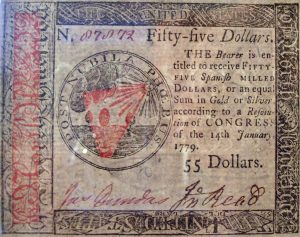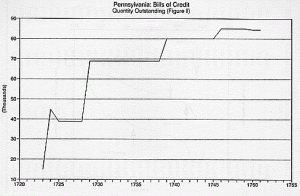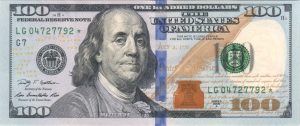Theory and Mechanics
By: Jacob Salamy
Introduction
Fiat money is currency that is not convertible to any underlying asset. Although fiat money underpins the modern global financial system, its development required years of careful political engineering. For instance, it seems surprising that holders of U.S. currency could exchange dollars for gold up until 1971 considering that the circulation of fiat money in North America predates even the Revolutionary War. In this way, the inscription “Novus Ordo Seclorum” on the dollar bill alludes in equal parts to the “New Order of the Ages” of the post-revolutionary United States and the era of fiat money. This article employs the fiscal and monetary experiments of pre-revolutionary Pennsylvania to unpack the theory and mechanics of fiat money.

Definition of Fiat Money
Economists define the function of money as threefold: medium of exchange, store of value, and unit of account. Fiat money fulfills these criteria without being convertible to any underlying asset.
Medium of exchange refers to whether the currency is easily transferrable from person to person and commonly used in economic transactions. This function eliminates the transaction costs associated with bartering or extending private credit.
Store of value refers to whether the currency maintains a stable exchange rate for goods and services. This function allows people to spend money received in the past at par in the future.
Unit of account refers to the ability of a currency to reflect relative prices. This function allows consumers to comparison shop, as well as keep accurate financial records.
Convertibility refers to the exchange of paper currency for a tangible asset such as precious metals. In the past, this function served to bolster trust in a currency.
Fiat money today is backed only by a general consensus that the paper money will continue to meet the three standard criteria. To this end, public policy can either promote or undermine trust in a currency. However, trust in fiat money is not regulated through legal tender laws or fixed exchange rates, but rather from the quantity of paper currency relative to the amount of internal trade (Grubb, 5). This type of socio-monetary engineering is particularly salient in the case of Pennsylvania’s paper bills of credit.
Background
Leading up to the Revolutionary War, there was a great trade imbalance between the colonies and Britain. The price of the Pennsylvania’s produce had fallen on the international market and the resulting unfavorable balance of trade meant that most of the colony’s specie went to England via English merchants (Brock). This had a host of negative economic side effects, namely, increasing the costs of local exchange and therefore lowering wages, employment, and immigration (Grubb, 4). In response, Pennsylvania adopted a variety of measures designed to protect their local economy. Legislators even went so far as to pass a bill imposing a 10 percent tax on imports (Brock). Pennsylvanian’s soon sought to circulate their own paper money to facilitate local trade.

Economic Rationale
As an assemblyman in the 1740s and 50s, Benjamin Franklin was directly responsible for the administration of Pennsylvania’s paper currency (Grubb, 3). Although writing in support of paper money some several years following its first appearance in Pennsylvania, Benjamin Franklin makes clear the economic benefits of its circulation in a 1729 letter. Franklin first argues that a lack of money in any given country translates to burdensome interest rate. On the other hand, “[w]ith low interest rates, people invest in land; its price rises, and trade rises as people seek returns to capital beyond the low interest rates” (4). Moreover, Franklin maintains that a shortage of currency discourages economic activity and depresses the “the Price of that Part of its Produce which is used in Trade” (6). To this point, Professor Emeritus of History at the College of Idaho Leslie Brock estimated that the index of wheat prices (1720 = 100) had fallen to 88.6 in 1724, and during the same period, flour had fallen from 100.0 to 95.0 in Pennsylvania (Brock). Franklin also observed that a deficiency of currency discouraged laborers from moving to Pennsylvania (8). The long-run outcome of this decline in productivity is clear — the output of an economy further declines. Franklin is also quick to point out that this decline has further knock-on effects on the businesses of house-builders as declining demand translates to lower rents. Franklin concludes by pointing out that a want of a local currency “occasions a greater Consumption of English and European Goods” which in turn depresses demand for locally-made goods (10). All in all, the reasons for supporting the circulation of a localized paper currency are clear — it boosts the regional economy.
Mechanics
In 1723, Pennsylvania’s General Assembly passed a bill outlining their plan to issue paper currency. Lieutenant-governor of Pennsylvania and Delaware William Keith notably remarked that this currency was “an imaginary Specie which fully answers the End of permanent Currency and Measure of Trade amongst Ourselves” (“Paper Money…”, 541). This bill established a sunk fund in the form of a General Loan Office where landowners could mortgage up to half the value of their land and receive paper bills of credit. The paper currency was distributed by officers who would both dole out and call back the currency to pay for taxes. The initial plan was for the officers to call back the notes over 8 years at annual interest of 5% to be paid in paper money. Once called back, the landowner’s mortgage would be struck off the books. However, after making plans to meet once a year to determine whether the paper money supply was sufficient, Pennsylvania issued an increasing amount of notes. (See the graph below.) Pennsylvanians could also receive the notes in exchange for a deposit of specie. If the depositor failed to return the notes, the loan officer would sell the specie and return the surplus from the sale to the depositor. Depositors could also appeal the loss of their home if they defaulted on paper money loan (“Paper Money…”).
On Leslie Brock’s view, these issues served three purposes:
- They supplied individuals with the credit necessary for acquiring and improving land in an age when private banks were unknown.
- Interest payments contributed to the public revenue.
- The bills themselves supplied a medium of exchange.
However, Pennsylvania sought to engineer trust in the value of its paper money beyond its financial technicalities. To this point, the Paper Money Act of 1723 stipulated that persons refusing to receive notes as payment of debts shall receive nothing, which is the textbook definition of a legal tender law. Moreover, Pennsylvania prescribed draconian punishments for counterfeiters. Besides a fine of $100, counterfeiters could expect to have their ears cut off and to be place in the pillory for days on end. Some forgers were even place into indentured servitude for up to seven years. The intricate designs on the bills printed by Benjamin Franklin also served to boost trust in the paper money by making counterfeiting more difficult. In this sense, Pennsylvania’s fiat currency was closely aligned with John Locke’s perception of the value of specie in that it only has “imaginary value” by reason of its “durability, scarceness, and inability to counterfeit” (“Some Considerations…”).

To return to the previous broad definition of money, Pennsylvania’s paper currency met all three criteria.
Medium of Exchange: Benjamin Franklin said it best when explaining why these notes served as an improved medium of exchange over specie: “a great Sum is more easily counted in Them, [they are] lighter in Carriage, concealed in less Room, and therefore safer in Travelling or Laying up, and on many other Accounts they are very much valued” (21). In summary, these notes were much more convenient to use as long as they met the following two criteria.
Store of Value: Pennsylvania’s fiat currency was a stable store of value primarily because people trusted in the limited quantity of the bills. Beyond that, the paper money could be used to pay taxes. That the government accepted these bills in this way is a solid support of their circulation at par.
Unit of Account: Pennsylvania’s paper money was a unit of account primarily through the loan officer’s assessment of the land and homes that were mortgaged in exchange for the notes. This benefitted farmers in particular, who needed liquid assets while their money was tied up in their land and upcoming harvest. These notes also meant that people could reliably measure their debts.
Christine Desan broadly defines making money as “a collective activity that links individuals and communities” (42). This definition is important in the context of the American colonies, which struggled to keep specie and currency on hand due to trade imbalances with Britain. In this way, the circulation of fiat money precipitated the colonies push for independence from England. It was ultimately political movement rooted in ideals of communal trust, not an naturally occurring economic phenomena.

Brock, Leslie. “The Colonial Currency, Prices, and Exchange Rates.” http://people.virginia.edu/~ms3uf/brock/brock34.htm
Desan, Christine. Making Money: Coin, Currency, and the Coming of Capitalism. Oxford University Press, 2015.
Franklin, Benjamin. “ A Modest Enquiry into the Nature and Necessity of a Paper-Currency.” 3 Apr. 1729, Philadelphia, Pennsylvania.
Grubb, Farley. “Benjamin Franklin and the birth of a paper money economy.” 2006. https://www.philadelphiafed.org/-/media/publications/economic-education/ben-franklin-and-paper-money-economy.pdf
Locke, John. “Some Considerations of the Consequences of the Lowering of Interest, and the Raising the Value of Money.” Received by A Member of Parliament, 1691, London, England.
“The Paper Money Act of 1723”. Pennsylvania General Assembly. 1723.